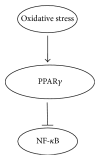PPAR γ and Its Role in Cardiovascular Diseases
- PMID: 28243251
- PMCID: PMC5294387
- DOI: 10.1155/2017/6404638
PPAR γ and Its Role in Cardiovascular Diseases
Abstract
Peroxisome proliferator-activated receptor Gamma (PPARγ), a ligand-activated transcription factor, has a role in various cellular functions as well as glucose homeostasis, lipid metabolism, and prevention of oxidative stress. The activators of PPARγ are already widely used in the treatment of diabetes mellitus. The cardioprotective effect of PPARγ activation has been studied extensively over the years making them potential therapeutic targets in diseases associated with cardiovascular disorders. However, they are also associated with adverse cardiovascular events such as congestive heart failure and myocardial infarction. This review aims to discuss the role of PPARγ in the various cardiovascular diseases and summarize the current knowledge on PPARγ agonists from multiple clinical trials. Finally, we also review the new PPARγ agonists under development as potential therapeutics with reduced or no adverse effects.
Conflict of interest statement
The authors declare that they have no competing interests.
Figures
Similar articles
-
Peroxisome Proliferator-Activated Receptor-γ Is Critical to Cardiac Fibrosis.PPAR Res. 2016;2016:2198645. doi: 10.1155/2016/2198645. Epub 2016 May 12. PPAR Res. 2016. PMID: 27293418 Free PMC article. Review.
-
Peroxisome proliferator-activated receptor (PPAR) gamma in cardiovascular disorders and cardiovascular surgery.J Cardiol. 2015 Oct;66(4):271-8. doi: 10.1016/j.jjcc.2015.05.004. Epub 2015 Jun 10. J Cardiol. 2015. PMID: 26072262 Review.
-
A step ahead of PPARγ full agonists to PPARγ partial agonists: therapeutic perspectives in the management of diabetic insulin resistance.Eur J Pharmacol. 2015 May 15;755:50-7. doi: 10.1016/j.ejphar.2015.02.043. Epub 2015 Mar 5. Eur J Pharmacol. 2015. PMID: 25748601 Review.
-
PPAR ligands: are they potential agents for cardiovascular disorders?Pharmacology. 2007;80(1):1-10. doi: 10.1159/000102594. Epub 2007 May 10. Pharmacology. 2007. PMID: 17496434 Review.
-
Peroxisome Proliferator-Activated Receptor (PPAR) Gamma Agonists as Therapeutic Agents for Cardiovascular Disorders: Focus on Atherosclerosis.Curr Pharm Des. 2017;23(7):1119-1124. doi: 10.2174/1381612823666161118145850. Curr Pharm Des. 2017. PMID: 27855608 Review.
Cited by
-
Sildenafil protects against pulmonary hypertension induced by hypoxia in neonatal rats via activation of PPARγ‑mediated downregulation of TRPC.Int J Mol Med. 2022 Feb;49(2):19. doi: 10.3892/ijmm.2021.5074. Epub 2021 Dec 22. Int J Mol Med. 2022. PMID: 34935055 Free PMC article.
-
An Upstream Open Reading Frame Represses Translation of Chicken PPARγ Transcript Variant 1.Front Genet. 2020 Feb 28;11:165. doi: 10.3389/fgene.2020.00165. eCollection 2020. Front Genet. 2020. PMID: 32184808 Free PMC article.
-
C/VDdb: A multi-omics expression profiling database for a knowledge-driven approach in cardiovascular disease (CVD).PLoS One. 2018 Nov 12;13(11):e0207371. doi: 10.1371/journal.pone.0207371. eCollection 2018. PLoS One. 2018. PMID: 30419069 Free PMC article.
-
Inactivation of carboxyl terminus of Hsc70-interacting protein prevents hypoxia-induced pulmonary arterial smooth muscle cells proliferation by reducing intracellular Ca2+ concentration.Pulm Circ. 2019 Sep 9;9(3):2045894019875343. doi: 10.1177/2045894019875343. eCollection 2019 Jul-Sep. Pulm Circ. 2019. PMID: 31523420 Free PMC article.
-
Qiliqiangxin attenuates isoproterenol-induced cardiac remodeling in mice.Am J Transl Res. 2017 Dec 15;9(12):5585-5593. eCollection 2017. Am J Transl Res. 2017. PMID: 29312510 Free PMC article.
References
-
- Ogawa S., Lozach J., Jepsen K., et al. A nuclear receptor corepressor transcriptional checkpoint controlling activator protein 1-dependent gene networks required for macrophage activation. Proceedings of the National Academy of Sciences of the United States of America. 2004;101(40):14461–14466. doi: 10.1073/pnas.0405786101. - DOI - PMC - PubMed
Publication types
LinkOut - more resources
Full Text Sources
Other Literature Sources



